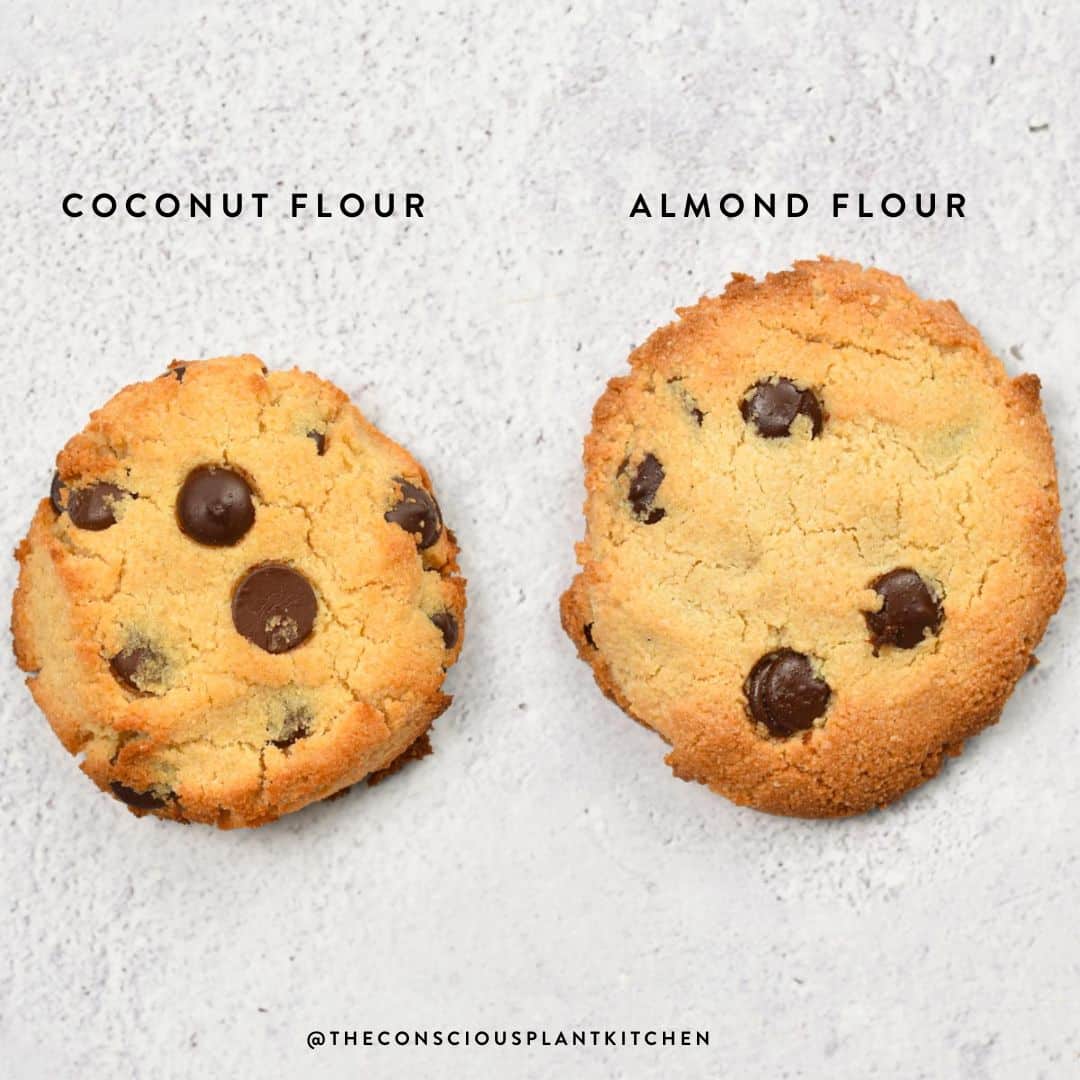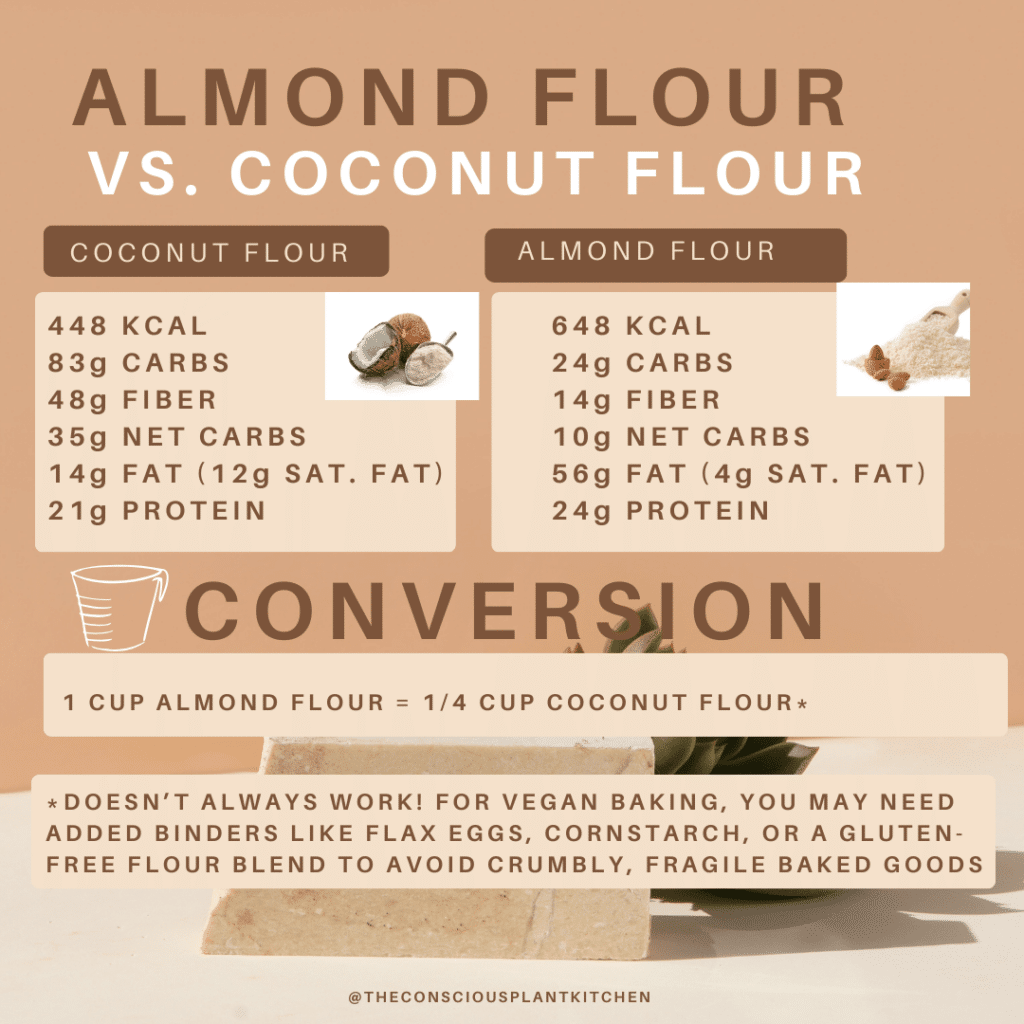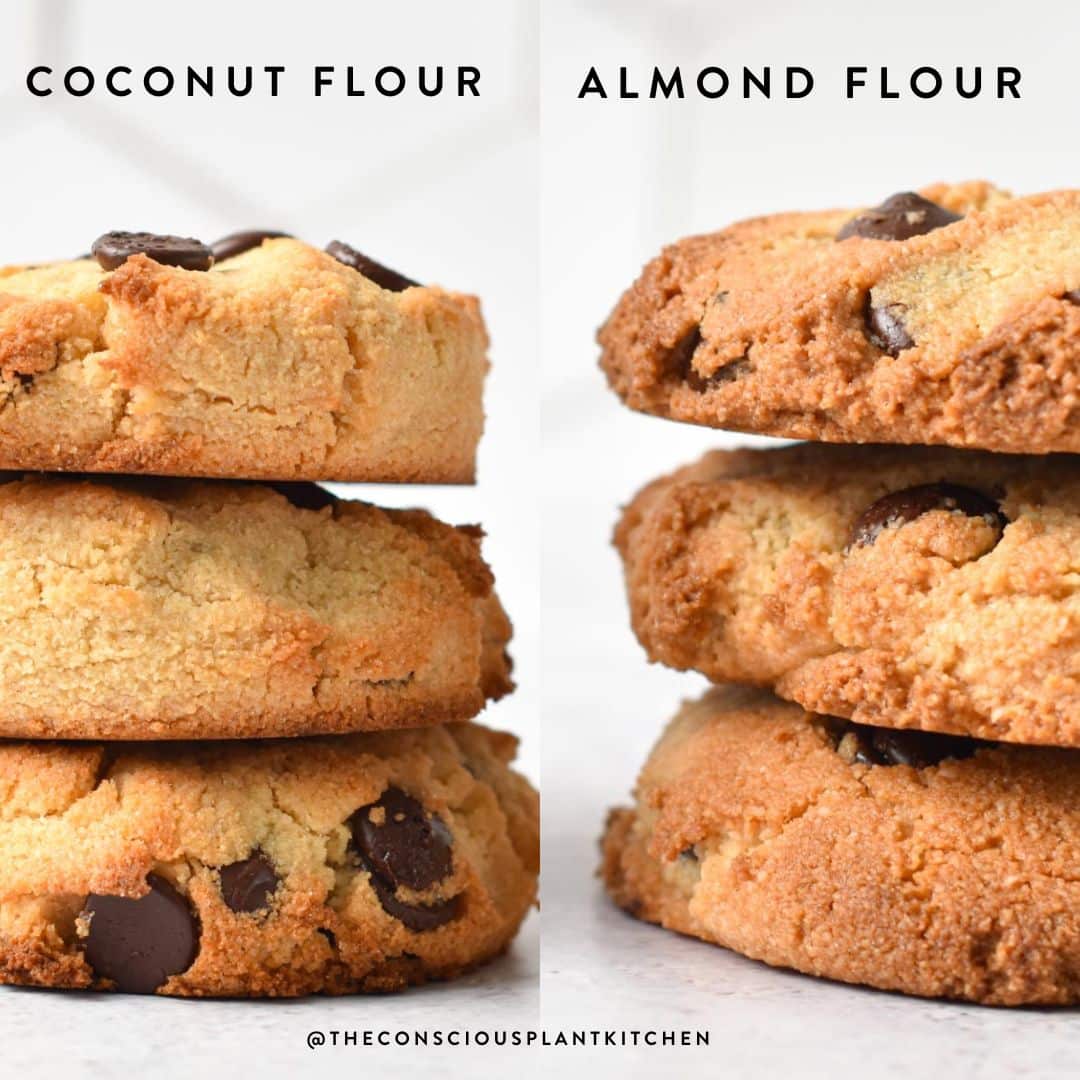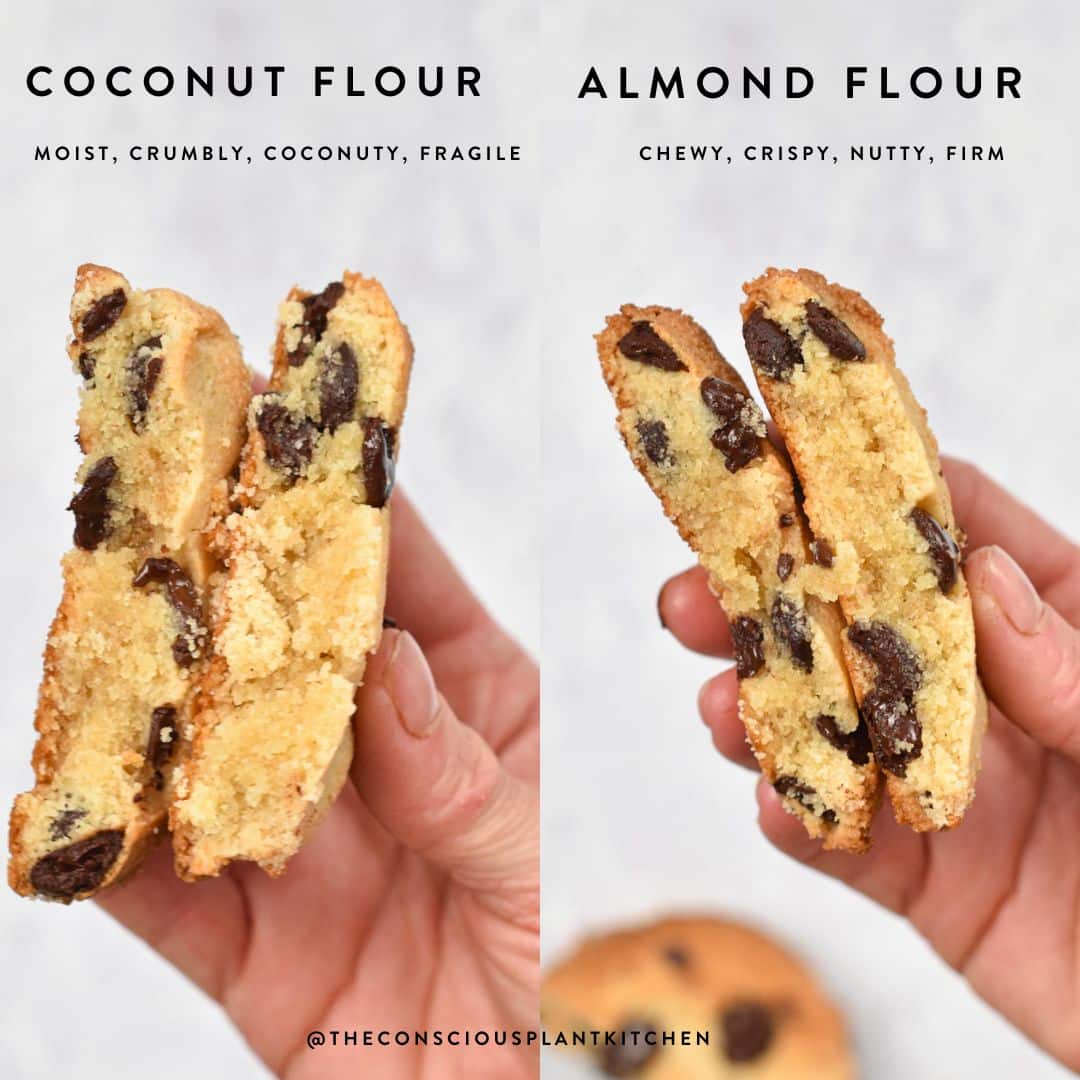The top query on The Conscious Plant Kitchen is often, “Can you substitute almond flour for coconut flour?” It’s a crucial question for anyone diving into vegan baking. As a seasoned baker with a penchant for experimenting with alternative flours, I’ve discovered the ins and outs of baking with almond and coconut flour. Let’s unravel the mystery.
To illustrate the difference between the two flours, I’ve baked the exact same cookies with almond flour or coconut flour. Same recipe, just a different flour. Read why and how they are so different!

I have shared so many almond flour and coconut flour recipes and on my keto blog, that I became an expert at baking with these two flours.
I have a passion for healthy baking in general, but especially in experimenting with atypical flours that are healthier for you, and this is what I want to share about coconut flour and almond flour.
Common Mistakes When Baking With Coconut Flour
- Swapping Cup For Cup. The number one mistake people make in baking with almond flour or coconut flour is to believe they are interchangeable weight-to-weight or volume-to-volume. If you swap 1 cup of almond flour with the same amount of coconut flour, you end up with ultra-dry, crumbly baked goods or simply a batter that turns into a rock and ends up in the trash.
- Not Adjusting The Recipe. Coconut flour needs way more moisture than almond flour or wheat flour. That’s why to substitute coconut flour with almond meal (or almond flour), you need to follow a conversion rule to avoid a dry batter. As a general rule you can replace 1 cup of almond flour with 1/4 cup of coconut flour, but this doesn’t mean you will end up with the same texture, and taste. Adding fat, binders like eggs or egg replacers if vegan like all my recipes here, is a must.
Coconut Flour To Almond Flour Conversion
Below, I attached a coconut flour conversion chart with all the nutrition information about both flours so you can see why both flours impact baked goods differently. Data are from Nutritionix, a trusted nutrition app and for 1 cup of each flour.

Best Replacement For Almond Flour
The best replacements for almond flour in baking with a 1:1 ratio are:
- Sesame seed flour
- Sunflower seed flour – watch out, sunflower seed products and baking soda turn baked goods greenish!
- Pumpkin Seed Flour
Coconut Flour vs. Almond Flour
There are three big differences between almond flour and coconut flour that impact any recipe you will bake with them.
Almond flour contains:
- 4 times more fat – It means almond flour baked goods are moister and require less liquid to stick together. When baking with coconut flour, it’s better to use way less at first. Then, if your batter is too wet, add more liquid, focusing on the fat to add a moist texture.
- 3.5 times less fiber – Fiber is highly-liquid absorbent. Since coconut flour contains way more fiber than almond flour, a recipe with coconut flour always needs more liquid than a recipe with almond flour. As a result, you need to drastically decrease the quantity of coconut flour amount to achieve a similar result to almond flour which in turns reduces the size of your baked goods!
- 3 times less saturated fat. This doesn’t impact the texture of baked goods, but if you are after better, healthier fat in your diet, almond flour is a healthier choice than coconut flour.
Expert Tips To Swap Almond Flour For Coconut Flour
While the ratio above is true most of the time, it also varies depending on the amount of wet ingredients used in the recipe.
So if you want to make a recipe with coconut flour instead of almond flour, follow the steps below:
- Add four times less coconut flour. Divide the amount of almond flour in the recipe by 4. Actually, if you are unsure, you can even divide it by 4.5. Starting with less coconut flour is my recommendation to play it safe because it’s easier to add liquid to compensate than to add coconut flour that quickly dries out a batter.
- Work in weight instead of cups. Coconut flour is so high in fiber that if you overpack the measuring cups, even a tiny bit, you end up with a consequent impact on the texture of your baked goods. Most of the time, too much coconut flour makes food ultra dry and fragile. Some people even refer to gaging when eating coconut flour cookies that are too high in coconut flour because the fiber is stuck in the throat.
- Add fat. Coconut flour is low in fat compared to almond flour, and if you want to keep your baked goods moist, you need to add fat to the recipe. It can be by swapping low-fat milk, like almond milk, for full-fat coconut milk or adding coconut oil.
- Add binder. You won’t find many vegan coconut flour recipes because coconut flour is so absorbent that it turns the recipes crumbly and fragile without eggs. That’s why so many coconut flour recipes use many eggs. But, for vegan baking with coconut flour, you can simply add binders like flax eggs, applesauce, cornstarch, or tapioca flour. Like in my vegan coconut flour pancakes, I use gluten-free flours as a binder, or apple sauce in my coconut flour oatmeal cookies.
- Rest coconut flour batter. When you bake with coconut flour, it’s essential to rest the batter for 10 minutes to give some to the fiber to suck up the wet ingredients. The texture will change drastically during that time.
- Remove lumps. Coconut flour must be stored in an airtight container, or it forms lumps as the fiber quickly absorbs moisture. If your coconut flour has lumps, place it in a food processor or shake the container before using.
- Decrease the add-ons. When you convert an almond flour recipe into a coconut flour recipe, you end up with a four-times smaller batch. As a result, you need to decrease the added chocolate chips or chopped nuts accordingly.
- Decrease the size of the cookies. As seen in the experiment below, coconut flour cookies are higher in fiber more fragile, and, therefore, shaping smaller cookies makes them firmer, and the portion is more accurate.
Best Things About Almond Flour And Coconut Flour
Both flours have a lot in common, that’s probably why so many of you want to swap almond flour for coconut flour in my recipes. Here’s what they share:
- Low-carb
- Perfect for the people following a keto diet
- Gluten-free
- High-protein – both have more than 20 grams of protein per cup
- High-fiber – from 14 grams of fiber for almond flour to 48 grams of fiber for coconut flour.
- Grain-free
- Paleo-friendly
Should I Bake With Coconut Or Almond Flour?
Choose coconut flour for recipes that:
- Contain a lot of liquid and binders like flax eggs. If so, you can easily bake coconut flour muffins, or coconut flour cakes.
- Nut-free or people with tree nut allergies.
- To bake raw desserts like my no-bake peanut butter bars.
- In combination with other flour to absorb excess of liquid like in my vegan cookie dough balls.
Choose almond flour if:
- You don’t like coconut flavor – coconut flour is made from coconut pulp. It has a strong coconut taste that some people don’t like.
- You love moister baked goods, like my almond flour pumpkin cookies or vegan gluten-free mug cake.
- Your recipe doesn’t contain eggs – It’s much easier to bake vegan almond flour recipes than vegan coconut flour recipes.
- You are after fewer grams of net carbs per serving.

Experiment – Swapping Almond Flour With Coconut Flour In Cookies
In the picture below, I baked a batch of my almond flour chocolate chip cookies following the recipe to the T, using exactly the same other ingredients, and cooked in the same oven at the same time.
One batch using four times less coconut flour where I swapped the 2 cups of almond flour for 1/2 cup of coconut flour.
Texture and Taste
The texture and taste are very different with coconut flour. The cookies with coconut flour are:
- Crumbly and fragile
- Soft, moist in the center, and fall apart in the mouth with no chewy texture.
- A bit difficult to swallow. You need to drink more.
- Very filling. Making cookies twice smaller would be better.

Almond Flour Recipes
Now that you’ve seen the difference between almond flour and coconut flour, have a look at my favorite almond flour recipes:










Leave a comment